Royal Amber: Circa 1978
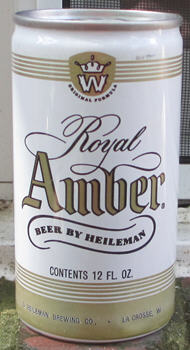 |
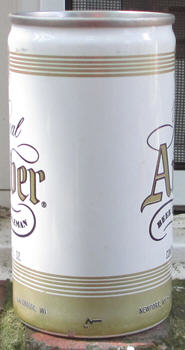 |
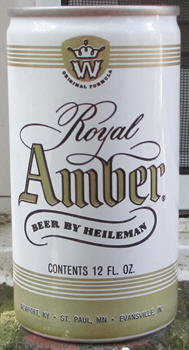 |
This month's can is an example of what commonly happened to old brands when their home brewery was sold. As small breweries continued to close in the 1960s, 1970s and 1980s, a number of mid-sized breweries began to buy them out in an attempt to expand market share. Often the quality of the old brands, now made by the new owner, suffered.
Royal Amber
Royal Amber was made by the Wiedemann Brewery in Newport, Kentucky, just across the river from Cincinnati. Their flagship brand was Wiedemann Beer, a lager. Royal Amber was their premium (i.e. higher priced) brand. In an older issue of Rustlings, one of the Rusty Bunch members who grew up in the Cincinnati/Northern Kentucky area remembered his Dad occasionally treating himself to a Royal Amber, finishing it and sighing, "Damn, that was a good beer."
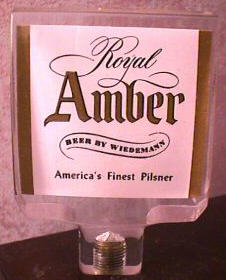 |
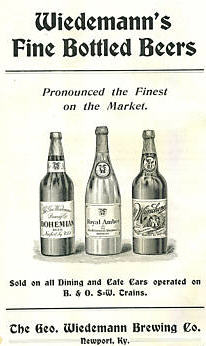 |
| A Royal Amber tap knob. 1960s? | A newspaper ad showing three Wiedemann brands. Royal Amber is in the middle. 1890s? |
G. Heileman and Royal Amber's Odyssey
La Crosse, Wisconsin's G. Heileman brewery was one of those regional breweries that expanded by buying other small breweries that were in trouble. As an example, let's say that Heilman purchased Brand X Brewery. Heileman would get the rights to the Brand X brands, an expanded production ability with the just-purchased Brand X brewery, and (this is crucial) an Brand X's established distribution network. That made it much easier for Heileman to expand into new areas.
Among the many historic brands that were consolidated into Heileman this way were Black Label, Blatz, Sterling, Blitz-Weinhard, Drewry's, Falls City, Grain Belt, National Bohemian, Olympia, Rainier, and Wiedemann. At its height the Heileman's combination was, albeit very briefly, the third largest brewer in the United States, behind Anheuser-Busch and Miller.
In 1967 when Heileman purchased Wiedemann, it was already well-versed in buying small, struggling breweries. For example.....
1960: Heileman purchased Kingsbury.
1962: They bought Fox Head.
1964: Heileman purchases the trademarks (brand names) from Gluek.
1964: They buy the Independent Milwaukee Brewery.
1965: General Brewing (aka Lucky) refuses an offer by Heileman to buy them.
1966; They buy the Duluth Brewing and Malting Company.
1966: Bavarian (part of International Brewing, another group that bought small breweries) sells Heileman the brands from Bavarian in Covington, Kentucky and Old Dutch in Findlay, Ohio.
So when they bought Wiedemann in 1967 Heileman was already establishing itself in Ohio and Kentucky. The strategy seemed to work. They were making a profit and gradually rising in rank among American brewers. In 1967 they were ranked #22 and produced 1,041,000 barrels of beer. In 1968 they were #20 and made 1,310,000. They were ranked #16 in sales for 1969 with 2,298,000 barrels.
Numerous other brands were made at the Wiedemann facility in Newport besides Wiedemann and Royal Amber: Blatz, Oertels '92, Old Style, Drewrys, Sterling, Kingsbury, Zing, and Pfeiffer were among the other labels that poured out of the brewery. Employment at the Wiedemann plant expanded. I remember buying some Wiedemann 3.2% beer in 1978 or so, when I was about 19. In Ohio at the time 3.2% was legal to buy if you were at least 18. Stronger beer was reserved for those at least 21 years old. I don't remember the Wiedemann being very good at the time. I don't know if the quality of the beer had suffered or if that was just the impression of a young man who had not had much experience with beer.
The Wiedemann brewery was producing a million barrels a year by the end of the 1960s, but the plant was a century old and even the newer equipment was wearing out. Moreover, Heileman had much more productive plants elsewhere, such as the former Pabst brewery in Georgia that could make six million barrels a year. In the spring of 1983 the old Wiedemann brewery closed. Heileman continued to make Royal Amber for a few more years, and Wiedemann as well, but eventually both brands disappeared. In 1996 Heileman was the 5th largest brewing company in the US but in serious financial trouble. They were purchased by Strohs, another mid-western brewery that was trying to expand by buying other breweries. They used to sponser the Cincinnati Reds on radio when the Reds played in Riverfront, right across the river from where the old Weidemann Brewery stood.
Strohs also tried expanding into the international market, but they went out of business in 2000 selling their brands to Miller and Pabst. So who owns the Royal Amber label now? I suppose it's either Pabst or Miller-Coors. Maybe some clever micro-brewer can recreate the original recipe and bring the brand back from the dead.
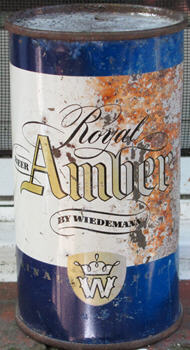 |
One of Wiedemann's Royal Amber flat top cans from the 1950s. Note the "By Wiedemann" banner on the front and comapre it to the same banner on the Heileman can at the top of the page. |
Sources Used
"G Heileman" (Wikipedia) Accessed 30 August 2013.
Holian, Timothy J. Over the Barrel: The Brewing History and Beer Culture of Cincinnati. Volume 2. Prohibition-2001. (Sudhaus, 2001)
Thanks to Rick Drake for the photos of Royal Amber stuff.
Brewery research on this page has been aided by Carlson's Brewery Research.
